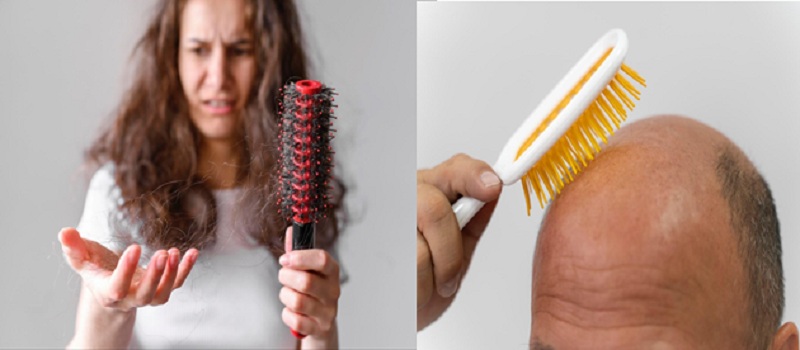Introduction:
Baldness is something that many people worry about in the modern world, and it does not matter if they are young or old or whether they are male or female. Trying to analyze the causes and the possibility of coming across efficient treatments will let people cope with the issue and improve the state of their hair. We have compiled this complete guide to understanding why hair loss occurs and current remedies for cases of hair loss, including PRP therapy, which helps to address issues such as baldness and hair thinning, and hair transplant surgery as well.
Understanding Hair Loss: Causes and Types
Hair loss, medically known as alopecia, can result from multiple factors such as genetics, hormonal changes, medical conditions, medications, and lifestyle choices. Here are some common types:

1. Androgenetic Alopecia:
This is the best-known type of baldness; it is androgenetic alopecia, which manifests in both male and female forms: male-pattern baldness and female-pattern baldness, respectively. Typically, it presents as hair thinning and baldness following a genetic and patterned distribution.
2. Telogen Effluvium:
In this type of hair loss, hair is lost in large amounts and is usually characterized by stress, disease or fluctuations in the hormonal system as hair follicles enter the phase of shedding.
3. Alopecia Areata:
A medical condition in which the body’s immune system targets hair follicles bringing about patchy hair loss in the scalp and other parts of the body.
4. Traction Alopecia:
Resulting from hairstyles that pull hair whether it is a braid, pony tail, or even a bun. If the condition remains unchanged then it would result in complete hair loss out of the root superstring.
5. Anagen Effluvium:
It is common with patients who have undergone chemotherapy and this occurs at one specific phase of the hair growth cycle.
Common Causes of Hair Loss:

a. Genetics:
A primary cause of hair loss is genetics which influence not only the pattern of hair loss, but also the intervention methods that can be employed in dealing with it. For instance, androgenetic alopecia is hereditary and does manifest in both male and female genders, ultimately causing gradual hair loss and potential baldness.
b. Hormonal Changes:
Estrogen affects the hair growth pattern in a profound way thus hormonal imbalances greatly affect hair health. The factors that lead to hair loss in women include polycystic ovary syndrome, PCOS, pregnancy, childbirth, and the menopausal period. In males, hormonal balances or imbalances, particularly the testosterone hormone, have been implicated in causing baldness in the male mainstream community.
c. Medical Conditions:
It is noteworthy that hair loss can be caused by several diseases. Common conditions that may affect hair growth cycle include thyroid disorders, scalp infections that include diseases such as ringworm, and autoimmune diseases such as lupus.
d. Medications:
Some of the common side effects include hair loss which is normally associated with some drugs. Chemotherapy drugs, sulfasalazine used in arthritis, antidepressant medications, catecholamines used for heart ailments and high blood pressure cause hair thinning and hair loss.
e. Lifestyle Factors:
A poor dieting regimen, lack of proper hair care, and stressful conditions impact the rate of hair shedding. When it comes to beauty, one of the important aspects of the body that can be affected in a negative manner is hair; it is a known fact that bad nutrition, especially in areas of iron, proteins, and vitamins, can lead to hair loss. In some cases, medications such as finasteride or dutasteride are used to help combat hair loss by blocking the hormones that contribute to it, offering a potential solution for those struggling with thinning hair.
Remedies for Hair Loss:
Here are the remedies to get rid of hair loss problems-

i. Lifestyle and Home Remedies
- Balanced Diet: It is possible to mention such nutrients required for hair health as iron, zinc, vitamin D, biotin, and others are consumed in a diet. Some of the choices of foods that could be useful include vegetables, green leafy veggies, almonds, seeds, fish, and lean meat. Additionally, supplements available on Amazon.com can help fill any nutritional gaps and support overall hair vitality.
- Stress Management: To avoid hair loss as a result of stress, people should embrace activities that reduce stress such as yoga, meditation, and exercising. The hormones related to chronic stress are known to move hair follicles into the resting phase, thus increasing hair shedding process.
- Proper Hair Care: In combination with proper care, gentle hair care practices including the no-pull hair policy, use of mild shampoos and reduction of heat styling, practically dispel the likelihood of traction alopecia.
ii. Medical Treatments
- Minoxidil (Rogaine): Aqueous solution that is applied directly to the hair, that is the scalp; it is available without prescription. It is helpful in stimulating hair follicles, encouraging regrowth of the hair that has been lost and also helps in slowing down the balding process. Their use applies to both genders and it is commonly used two times a day.
- Finasteride (Propecia): A prescription drug mainly administered orally and used widely among male patients. This is because the product acts as an anti-androgen, meaning, compensates for the reduced production of DHT, thereby preventing hair loss. Regular use may help prevent hair loss and help stimulate the growth of new hair when used as directed.
Advanced Treatments for Hair Loss:
· Platelet-rich plasma (PRP) Therapy:
PRP therapy is a new form of treatment which can really work on hair loss and uses the patient’s own blood. Here’s how it works:
- Blood Collection: A sample of the patient’s blood is taken, though this is just a small portion of the blood.
- Centrifugation: First, the blood is spun in a centrifuge to isolate the fluid called platelet-rich plasma from other materials.
- Injection: This is derma-roller and PRP therapy, which is an autologous procedure containing high growth factors injected to the areas of the scalp thinning hair.
These growth factors help improve the functionality of hair follicles, increase blood flow to the affected area, and result in the formation of new hair. PRP therapy is non-surgical and has been effective among individuals who started experiencing hair loss, especially in thinning hair.
· Hair Transplant Surgery:
Hair transplant surgery can be considered as a long-term solution for the highest level of baldness. There are two main techniques:
- Follicular Unit Transplantation (FUT): This technique entails shaving a strip of the scalp taken from the back of the head ( donor site) under local anesthesia, reducing it into tiny grafts containing individual follicular units, and implanting it in the bald zones. This technique can allow for up to the required number of grafts to be grafted and in one session, however, a linear scar is left behind.
- Follicular Unit Extraction (FUE): This method involves surgery where hair from areas of the head with dense hair mass are removed and grafted in the bald sections of the head. In this FUE is slightly superior to FUT concerning invasiveness, scarring, and the duration of healing. But it may take numerous appointments to reach desired density, which may be counterproductive.
The two approaches are designed more for the seemingly normal coverage; hair transplanted to the recipient site remains to grow throughout one’s life. Technological development has enhanced hair surgery procedures, with finely tuned accuracy and much better appearance results.
Conclusion:

Baldness is not a very pleasant experience but when one realizes the causes of this unpleasantry they can find solace in trying to seek remedies to the situation. Some of the causes of hair loss can easily be prevented while others require the use of various treatment methods which ranges from lifestyle changes to loosely invasive procedures such as PRP and hair transplant surgery among others.
Consulting with a healthcare professional or a trichologist is crucial for determining the most suitable approach based on individual needs and the underlying cause of hair loss. Embracing these solutions can help transform hair from shedding to shining, restoring both hair and confidence.



Thank you a lot for sharing this with all folks you actually understand what you’re talking approximately! Bookmarked. Please also consult with my web site =). We will have a link exchange agreement between us!
Your place is valueble for me. Thanks!…
Hi, just required you to know I he added your site to my Google bookmarks due to your layout. But seriously, I believe your internet site has 1 in the freshest theme I??ve came across. It extremely helps make reading your blog significantly easier.
Outstanding post, I conceive people should larn a lot from this weblog its very user genial.
Hi, Neat post. There is a problem with your site in internet explorer, would check this… IE still is the market leader and a huge portion of people will miss your fantastic writing due to this problem.
great post.Ne’er knew this, regards for letting me know.
I have been absent for some time, but now I remember why I used to love this web site. Thank you, I will try and check back more often. How frequently you update your web site?
I must convey my gratitude for your kindness in support of men and women who need guidance on this theme. Your real commitment to passing the message along appeared to be particularly powerful and have without exception permitted individuals just like me to get to their goals. This warm and friendly help means this much a person like me and especially to my office colleagues. With thanks; from all of us.
What i do not realize is if truth be told how you’re not really a lot more well-preferred than you might be right now. You are very intelligent. You understand therefore considerably relating to this subject, made me individually imagine it from numerous numerous angles. Its like men and women are not involved until it is one thing to accomplish with Lady gaga! Your personal stuffs nice. All the time deal with it up!
I was recommended this website by my cousin. I am not sure whether this post is written by him as no one else know such detailed about my trouble. You’re amazing! Thanks!
I don’t even know how I ended up here, but I thought this post was great. I do not know who you are but certainly you are going to a famous blogger if you aren’t already 😉 Cheers!
As a Newbie, I am permanently exploring online for articles that can help me. Thank you
My brother recommended I might like this web site. He was entirely right. This post actually made my day. You can not imagine simply how much time I had spent for this info! Thanks!
Thank you for the sensible critique. Me & my neighbor were just preparing to do some research on this. We got a grab a book from our area library but I think I learned more clear from this post. I’m very glad to see such great info being shared freely out there.
We are a group of volunteers and opening a new scheme in our community. Your website offered us with valuable information to work on. You have done an impressive job and our whole community will be grateful to you.